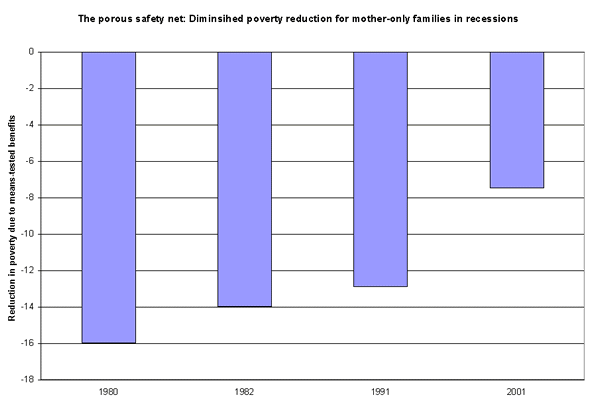Snapshot for November 6, 2002.
Our pro-cyclical safety net fails to catch vulnerable families in recession
Pulled by the strong economy and pushed by welfare reform, many single mothers entered the labor market-or increased their weeks and hours of work-over the latter 1990s. Social policy also underwent a significant shift over the period. Income-tested cash transfers, such as welfare payments, fell sharply as did the receipt of related non-cash transfers, such as food stamps and Medicaid. At the same time, transfers related to work were significantly expanded, including the Earned Income Tax Credit, a wage subsidy for low-income workers, and various work supports such as child-care subsidies.
Complemented by a strong economy and a tight labor market, these shifts helped to raise the incomes of mother-only families, and their poverty rates hit an historic low of 33% in 2000. In this economic environment, the new strategy was effective. Now, however, a critical shortcoming of this policy approach is becoming apparent.

The bars in the figure show the impact (percentage-point changes) of welfare benefits-cash transfers, food stamps, and Medicaid-on the poverty rates of persons in single mother families over four recessionary years. The poverty-reducing impact of such benefits was already diminishing slightly during the 1980’s, but more recently it dropped sharply: in 2001, the impact was especially slight, reducing the poverty rate by only 7.5 percentage points, compared with more than 12 points in prior recessions.
The problem is that the safety net for mother-only families has become decidedly “pro-cyclical”-it works well in a strong economy, and badly in a recession. The EITC and work support subsidies do not help the unemployed, and many low-income single mothers do not to meet eligibility requirements for Unemployment Insurance. When the safety net is largely tied to work, these economically vulnerable families have little protection from recession.
Source: These data are from Census analysis of the impact of various programs on poverty. The Census creates 15 definitions of income and measures the cumulative change in the poverty rate as new income components are added with each definition. The values in the figure represent the change in poverty rates for persons in single mother families moving from definition 10 to definition 14, as these definitions add the impact of the means-tested benefits noted above. years prior to 2001 are from Census publication P-60, No. 182-RD, pg. 111, and 2001 is from http://ferret.bls.census.gov/macro/032002/rdcall/2_001.htm.
This week’s Snapshot by EPI economist Jared Bernstein.
Check out the archive for past Economic Snapshots.
Preferred Citation: Economic Policy Institute, “Economic Snapshots, [insert date].” Washington, D.C.: Economic Policy Institute, 2002.
